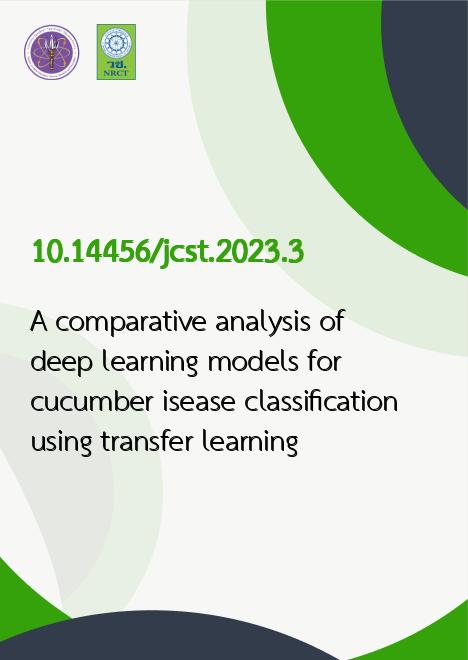
|
A comparative analysis of deep learning models for cucumber isease classification using transfer learning |
|---|---|
| รหัสดีโอไอ | |
| Creator | Amit Bhola |
| Title | A comparative analysis of deep learning models for cucumber isease classification using transfer learning |
| Contributor | Sahil Verma, Prabhat Kumar |
| Publisher | Rangsit University |
| Publication Year | 2566 |
| Journal Title | ๋Journal of Current Science and Technology |
| Journal Vol. | 13 |
| Journal No. | 1 |
| Page no. | 23-35 |
| Keyword | cucumber disease classification, deep learning, digital agriculture, plant disease, transfer learning |
| URL Website | https://jcst.rsu.ac.th |
| ISSN | 2630-0656 |
| Abstract | Increasing agricultural productivity continues to be a major challenge for society due to the rapid growth of the global human population and economic prosperity. However, improving agricultural productivity requires proper identification and minimization of diseases that degrade both the quality and quantity of the crops. The scientific community has stressed that the use of recent technologies such as deep learning, the internet of things, computer vision, etc. are vital to address various challenges in the agriculture sector. Furthermore, the use of computer vision to automatically identify diseases is growing in popularity. This paper provides a comparative analysis of six pre-trained deep learning models, namely VGG16, VGG19, ResNet50, ResNet101, InceptionV3, and Xception, for disease detection in cucumber plants. The pre-trained models are fine-tuned using transfer learning and evaluated using different metrics such as training accuracy, testing accuracy, and the number of epochs. The results obtained demonstrate that VGG16, despite being the smallest model in terms of the number of layers, outperforms the rest of the models in all of the evaluation metrics. The VGG16 models obtain testing accuracy of 98% and training accuracy of 99.91% while being trained for 8 epochs. In addition, it is observed that models with a larger number of layers, such as ResNet50 and ResNet101, exhibit fluctuations in accuracy while training due to the execution of fairly large models on a comparatively small dataset. However, InceptionV3 and Xception, despite having a greater number of layers, perform better than ResNet models due to the presence of Inception modules which are better equipped to detect different-sized targets. The findings of this study may be utilized to optimize the best-performing models for disease classification in other plants, and the fine-tuned VGG16 model can be integrated with mobile devices for real-time disease classification. |